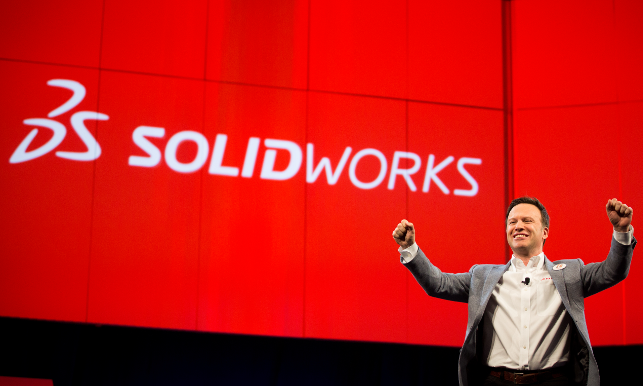
SolidWorks CEO Gian Paolo Bassi takes to the stage to welcome 8,000 attendees to this year’s event
#1 Generation X is here
With design tools in the cloud no longer sounding like fanciful witchcraft, XDesign and XDrive were announced as the event’s main technology preview.
The message here is that SolidWorks is no long a product, but a platform – and one that contains no fewer than 20 individual products, including the latest browser-based options.
XDrive, for example, is an online storage tool, similar to Dropbox or Google Drive, but one that also boasts a powerful search engine for discovering parts by shape.
XDesign, meanwhile, represents SolidWorks’ full entry into 3D design in the cloud, via any device. While recent releases of Solidworks Mechanical Conceptual and Industrial Design have offered a combination of cloud-based storage with desktop-based processing and user interface (UI), XDesign will run both storage and processing elements fully in the cloud, with only the UI remaining on the device, accessed via a browser window.
This is set to be a fully-fledged CAD product in its own right, so the announcement is about far more than simply sticking an existing tool in the cloud. CEO Gian Paolo Bassi envisions XDesign as a way to bring design guidance and shape optimisation to the front end of the design process, ready to take advantage of cloud-powered simulation and new manufacturing methods.
It’s yet to be seen if an intricate engineering model can be created using touch gestures, he told attendees, but added: “There’s a lot of future and investment in the line. It has a lot of legs.”
Pricing is yet to be announced, although we’re told that a huge beta testing programme is planned among existing SolidWorks users and that their feedback will drive future pricing decisions.
In the meantime, third-party developers are already beginning to create products and SolidWorks Visualize is already being engineered to run in the cloud – on which topic, more to follow.
#2 Visualize is looking pretty
SolidWorks’s new standalone rendering tool, SolidWorks Visualize, sees technology acquired in Dassault Systèmes’ purchase of Bunkspeed find a permanent and promising home.
With a slick, five-button, SolidWorks-themed UI, there’s a lot to like about Visualize. The standalone Standard version will be available for $1,495, while the Pro version costs $2,995.
However, the big news from SolidWorks World (SWW) was that Standard is now packaged for free with all SolidWorks Professional purchases. As soon as this announcement was made, the event was immediately awash with attendees downloading the software and testing out its functionality for themselves.
With its unrestricted access to the SolidWorks backend workings and development teams working together, Visualize is being promoted as the best SolidWorks file importer in the business – and that claim is probably valid, with one million polygons uploading per minute, according to company executives.
As a standalone product, Visualize has the ability to import 24 CAD file types, an intriguing prospect for non-SolidWorks users and one that could tempt many of them into becoming license holders.
Given that there hasn’t been a Bunkspeed Shot release since 2014, many of those users who were most comfortable with those tools (or have yet to move on) will be pleased to see the product’s return, albeit with a new name and branding.
The fact that it’s free to thousands of qualifying license holders could lead to an uncomfortable situation with vendors of third-party rendering products, but Bassi was keen to portray this as a logical step: “Customers have a choice, a flexibility – and this is it.
We’re not going to stop our relationship with KeyShot or anyone else. We have contracts in place and we honour our contracts.”
Current rendering tool PhotoView 360 will continue to exist, but it’s clear that Visualize is stepping up to become SolidWorks’ favourite child, at least in rendering terms.

#3 Community spirit flourishes
As with all SWW events, community was a key theme, but this year, it was extended to include new software projects and an interesting new services business model.
MySolidWorks, for example, is set to blossom from a somewhat underused way to find training materials to a thriving marketplace where designers and manufacturers connect.
“Sixty to seventy percent of the jobs manufacturers get in the US come in SolidWorks format,” Bassi told attendees.
It’s a “universal language”, he argued, but despite that fact, manufacturers still struggle to introduce themselves in new markets.
MySolidWorks is envisaged as ‘an Uber for engineering’ – a platform where manufacturers register, giving details of their capabilities and availability, and work is directed their way as appropriate.
The platform is expected to take a further step forward in the near future, when design services are added.
This, according to SolidWorks, will enable design and engineering students to earn some extra cash and increase their work experience at a rate of around 20 hours per week.
At the same time, it could help meet huge demand for flexible workers. It’s not in place yet and the team behind MySolidWorks is continuing to develop ideas around ratings systems and verification standards – but the desire and ambition to become a prevalent design service provider was certainly in evidence.
With further education covered, the community theme of SWW 2016 also touched on the opposite end of the educational spectrum as a new line of SolidWorks apps for kids was unveiled.
Six apps have been created for primary/elementary schools, each representing an individual stage of the end-to-end design process in the form of an easy-to-use 3D tool.
Currently in beta mode, these include tools for taking pictures; creating 3D shapes and decorating them; mechanising them or sending them to be 3D printed; and an app for showand-tell purposes (typically known to grown-ups as design review).
With SolidWorks currently being taught in around 30,000 schools worldwide, the ideas shown this year are clearly designed to win the loyalty, early on, of future designers and their bosses.
#4 IoT means getting connected
Eager to stress its relevance in a future of connected devices, SolidWorks is looking to bring together the worlds of product design and connected devices with its new SolidWorks PCB Design software.
A result of its partnership with electronic CAD (ECAD) developer Altium, this creates printed circuit board designs, embedding Altium’s leading PCB design capabilities in a SolidWorks-friendly UI.
Similar to Visualize, the new product is a standalone tool on the SolidWorks Platform, but its role is to provide a portal through which designers and engineers can access the company’s wider ‘Connected Ecosystem’.
The audience at SWW was regularly reminded of Dassault’s acquisition of the ‘industry leading’ NetVibes for data automation.
Dassault CEO Bernard Charles even turned up in person to tell us more about his $26 million ‘secret weapon’ in the IoT battle. Yet despite the fanfare, attendees learned little more about what the technology can or will achieve for them.
By contrast, a good deal more information was available on Xively, SolidWorks’ preferred partner for web infrastructure and embedded systems.
The company takes physical products through from working prototype to production, building all the required infrastructure to connect them and to manage their data, once they’re up and running.
As far as the company’s larger IoT vision goes, concentrating on physical design elements and partnering with solution providers for the rest could play to SolidWorks’ strengths. In a sector that has seen CAD companies make big investments in fast-changing waters, this gives the company some much needed flexibility.
#5 SolidWorks is here to listen
SolidWorks may well be a ‘platform, not a product’ these days – but plenty still use the company’s workhorse desktop software day in, day out and this continues to receive wide-ranging updates and tweaks.
DEVELOP3D will be running readers through a more in-depth review of these once we get our hands on the upcoming beta release, but as you’d expect, many enhancements will focus on ease of use and on timesaving workflow efficiencies.
That said, top of the list of priorities for SolidWorks has been responding to a customer outcry over a recent re-engineering of the product’s UI, with many demanding a reinstatement of the previous UI colourway.
Here, SolidWorks has shown that it listens – and the former UI is once again available to customers. It’s just a view option, with the updated version remaining as the standard view, but it’s available to those who feel they want or need it.
This squabble, now resolved, neatly represents SolidWorks’ wider challenge as it sprints towards the cloud and IoT – its own popularity. In other words, it must take giant leaps forward, without leaving behind or alienating a large, loyal and clearly vocal community of customers.
Five things we learned at this year’s flagship SolidWorks event
Default






